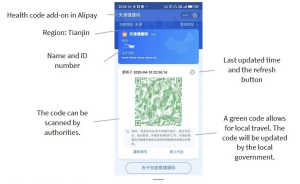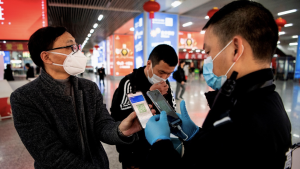Big Data to Battle COVID
By Anonymous | June 16, 2022
How China used new technology to control the spread of the deadly disease, but can it be recreated in the west and at what expense to personal privacy?
When COVID first emerged on the world stage in late 2019, many governments were unprepared to respond to a global pandemic. Despite being the initial source of the outbreak, China has arguably been one of the best at containing and limiting the spread of the virus. That success is often credited in part to new technologies they deployed, but critics have questioned whether it comes at the expense of personal privacy and if it could be reproduced in other countries.
Containing COVID through Smart Phones & A New “Health Code” System
Within weeks of the virus first being detected, two tech giants in China, Alibaba and Tencent quickly began developing competing but similar solutions to tackle the challenge of controlling the spread of the virus. On February 9th, WeChat and AliPay, two of the biggest smartphone apps used in China, launched “health code” systems that use multiple sources of data to determine your exposure risk and display a green, yellow or red QR code to indicate your risk level (Liang, 2020). Green indicates the user is healthy and able to travel freely. Yellow or red indicates a risk of exposure and the need to quarantine. The solutions were quickly adopted by local governments, employers and business across China and became mandatory in over 300 cities for entry into public places like restaurants, grocery stores or transportation. Within its first month, the WeChat app alone had been used over 6 billion times (CSIS, 2020).

Solutions like this have been credited with helping China contain the spread of COVID much more effectively than most other countries. For example, in June of 2020, a rare “super spreader” event occurred at a wet market in Beijing and hundreds of individuals were infected. In a densely populated city of 21 million people, this represented a significant risk to China’s containment efforts but through the use of this system, mass testing and containment, the number of new infections was back to zero within three weeks (Tian, 2020).

Figure 2: A person’s health code is scanned and validated at a checkpoint (CSIS, 2020)
How does the health code system work?
The reality is there is very little public information about the exact algorithm used to determine an individual’s exposure risk “color code” or how the data is managed. In past interviews, the Alipay parent company has declined to answer questions and has only stated that “government departments set the rules and control the data” (Mozur, et al, 2021). What is known is that the system relies on a considerable amount of personal data. Users self-certify whether they have any COVID symptoms, information about their movements comes from their “check ins” at public places as well as geolocation data from the phone carriers and finally their personal interactions are mined from their digital transactions with others (Liang, 2020). This is combined with data from local health authorities about infections to determine whether the user was in a high-risk location or interacted with someone with known exposure (Zhang, 2022).
A Model for Other Countries?
Could this model be recreated in western countries? Not likely. The amount of personal data being collected by private/government entities, the lack of transparency about how its used, and the fact that the use of this system is required, conflicts with the trend towards data privacy in most western nations. Multiple privacy standards including the General Data Protection Regulation (GDPR), California Consumer Privacy Act (CCPA), Children’s Online Privacy Protection Act (COPPA) and the Health Insurance Portability and Accounting Act (HIPAA) would make navigating implementation difficult and the many concerns they raise about user consent and risk of misuse from this mass surveillance would need to be addressed. Additionally, an estimated 12% of the U.S. population don’t own a smartphone which risks harm to this population and would impact it’s success (Kolmar, 2022).
Most importantly is the human element. The health code system is a tool but its effectiveness depends on mass adoption by the population and governments would need to deploy significant resources to enforce its use like we see in China. Given the high priority many western countries place on individual freedoms and the challenges experienced in adopting even simple masking policies, it suggests the health code system is a good fit for China, but difficult to reproduce outside its borders.
References
- Zhou, S. L., Jia, X., Skinner, S. P., Yang, W., & Claude, I. (2021). Lessons on mobile apps for COVID-19 from China. Journal of Safety Science and Resilience, 2(2). https://doi.org/10.1016/j.jnlssr.2021.04.002
- China’s Novel Health Tracker: Green on Public Health, Red on Data. (2020). CSIS: Center for Strategic & International Studies. https://www.csis.org/blogs/trustee-china-hand/chinas-novel-health-tracker-green-public-health-red-data-surveillance
- Liang, F. (2020). COVID-19 and Health Code: How Digital Platforms Tackle the Pandemic in China. Social Media + Society, 6(3), 205630512094765. https://doi.org/10.1177/2056305120947657
- O’Neill, P. H. (2020, October 9). A flood of coronavirus apps are tracking us. Now it’s time to keep track of them. MIT Technology Review. https://www.technologyreview.com/2020/05/07/1000961/launching-mittr-covid-tracing-tracker/
- Tian, T. (2020, July 16). Covid health code reveals China’s big data edge. Fidelity International. https://www.fidelityinternational.com/editorial/blog/covid-health-code-reveals-chinas-big-data-edge-71af0e-en5/
- Zhang, P. (2022, April 5). The colour-coded Covid app that’s become part of life in China – despite the red flags. South China Morning Post. https://www.scmp.com/news/china/science/article/3173123/colour-coded-covid-app-thats-become-part-life-china-despite-red
- Kolmar, C. (2022, June 7). S. Smartphone Industry Statistics [2022]: Facts, Growth, Trends, And Forecasts – Zippia. Zippia. https://www.zippia.com/advice/us-smartphone-industry-statistics/#:%7E:text=12%25%20of%20Americans%20own%20non,of%20Americans%20were%20smartphone%20owners.
- Mozur, P., Zhong, R., & Krolik, A. (2021, July 26). In Coronavirus Fight, China Gives Citizens a Color Code, With Red Flags. The New York Times. https://www.nytimes.com/2020/03/01/business/china-coronavirus-surveillance.html
